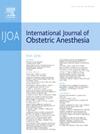“This is how we do it” Maternal and fetal anesthetic management for fetoscopic myelomeningocele repairs: the Texas Children's Fetal Center protocol
IF 2.6
3区 医学
Q2 ANESTHESIOLOGY
引用次数: 0
Abstract
Prenatal repair of myelomeningocele (MMC) is associated with lower rates of hydrocephalus requiring ventriculoperitoneal shunt and improved motor function when compared with postnatal repair. Efforts aiming to develop less invasive surgical techniques to decrease the risk for the pregnant patient while achieving similar benefits for the fetus have led to the implementation of fetoscopic surgical techniques. While no ideal anesthetic technique for fetoscopic MMC repair has been demonstrated, we present our anesthetic approach for these repairs, including considerations for both the pregnant patient and the fetus. We emphasize the importance of the preoperative consultation to optimize any medical conditions and to set expectations for the perioperative course. Our preferred anesthetic technique for the pregnant patient includes general anesthesia with an epidural for postoperative analgesia. Intraoperative anesthetic considerations for patients undergoing fetoscopic surgery include tocolysis, meticulous control of hemodynamics, judicious fluid administration, and maternal temperature regulation. We also avoid long-acting neuromuscular blocking agents due to significant weakness observed when given in combination with magnesium sulfate. While the maternal anesthetic crosses the placenta, direct administration of anesthesia to the fetus is required to reliably blunt the stress response. Additional considerations for the fetus include monitoring, fetal resuscitation strategies, and the theoretical risk of anesthetic neurotoxicity. Postoperatively, we use a multi-modal, opioid sparing regimen for analgesia. As advances in fetal surgery aiming to minimize risk to the pregnant patient alter the surgical approach, maternal-fetal anesthesiologists must adapt and incorporate the unique considerations of fetoscopy into their anesthetic management.
“我们就是这样做的”胎儿镜下脊髓脊膜膨出修复的母婴麻醉管理:德克萨斯儿童胎儿中心协议。
与产后修复相比,脊髓脊膜突出(MMC)的产前修复与脑室-腹膜分流术所需的脑积水发生率较低以及运动功能改善有关。为了开发侵入性更小的手术技术,以降低孕妇的风险,同时为胎儿带来类似的好处,已经导致了胎儿镜手术技术的实施。虽然没有理想的麻醉技术用于胎儿镜下MMC修复,但我们提出了我们的麻醉方法用于这些修复,包括对孕妇和胎儿的考虑。我们强调术前咨询的重要性,以优化任何医疗条件和设定围手术期的期望。我们对孕妇的首选麻醉技术包括全身麻醉加硬膜外麻醉用于术后镇痛。胎儿镜手术患者术中麻醉应注意的事项包括:胎儿溶解、细致的血流动力学控制、明智的液体给药和产妇体温调节。我们也避免长效神经肌肉阻滞剂,因为与硫酸镁联合使用时观察到明显的虚弱。当母体麻醉通过胎盘时,需要直接给胎儿麻醉以可靠地减弱应激反应。对胎儿的其他考虑包括监测、胎儿复苏策略和麻醉神经毒性的理论风险。术后,我们使用多模式,阿片类药物节约方案进行镇痛。随着胎儿手术技术的进步,旨在将妊娠患者的风险降至最低,改变手术方法,母胎麻醉师必须适应并将胎儿镜检查的独特考虑纳入其麻醉管理。
本文章由计算机程序翻译,如有差异,请以英文原文为准。
求助全文
约1分钟内获得全文
求助全文
来源期刊
CiteScore
4.70
自引率
7.10%
发文量
285
审稿时长
58 days
期刊介绍:
The International Journal of Obstetric Anesthesia is the only journal publishing original articles devoted exclusively to obstetric anesthesia and bringing together all three of its principal components; anesthesia care for operative delivery and the perioperative period, pain relief in labour and care of the critically ill obstetric patient.
• Original research (both clinical and laboratory), short reports and case reports will be considered.
• The journal also publishes invited review articles and debates on topical and controversial subjects in the area of obstetric anesthesia.
• Articles on related topics such as perinatal physiology and pharmacology and all subjects of importance to obstetric anaesthetists/anesthesiologists are also welcome.
The journal is peer-reviewed by international experts. Scholarship is stressed to include the focus on discovery, application of knowledge across fields, and informing the medical community. Through the peer-review process, we hope to attest to the quality of scholarships and guide the Journal to extend and transform knowledge in this important and expanding area.

 求助内容:
求助内容: 应助结果提醒方式:
应助结果提醒方式:


